How To Draw A Person In A Wheelchair
Today we will bear witness y'all how to depict or breathing the human figure walking or running. This drawing lesson is perfect for the person who wants to make an animation of a person walking or running…or for the artist who needs references of walking figures. This tutorial is taken from a book from E.G. Lutz..he was the master of blitheness before the use of computers.
How to Draw and Animate the Man Figure Walking or Running – Huge Guide and Tutorial
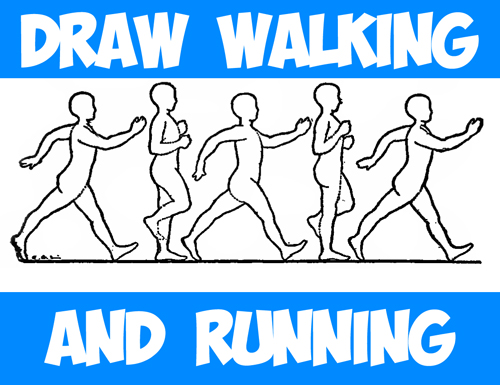
If you want to learn how to animate, one of the first things yous volition need to acquire how to draw is the blithe walk. You must become skilled in this earlier mastering running. The motion of the limbs and body give the advent of walking, and y'all must get it merely right to form that illusion. The motion of the lower limbs affects the torso as well as the arms. The arms and shoulders swing is rhythm with the legs to maintain the equilibrium of the person. When you, every bit an creative person, understand the bones facts of the movement of the human figure, y'all will and so be prepare to understand the movement of animals as well.
To start, nosotros are just going to focus on the movement of the legs. Imagine at present that the person you are drawing is walking. The body in the air, about thirty inches above the ground, is moving forwards. Fastened to this figure are the legs, alternately swinging and supporting the torso in its position higher up the ground. Further to simplify our written report, nosotros will, at first, consider the mechanism of one limb just.
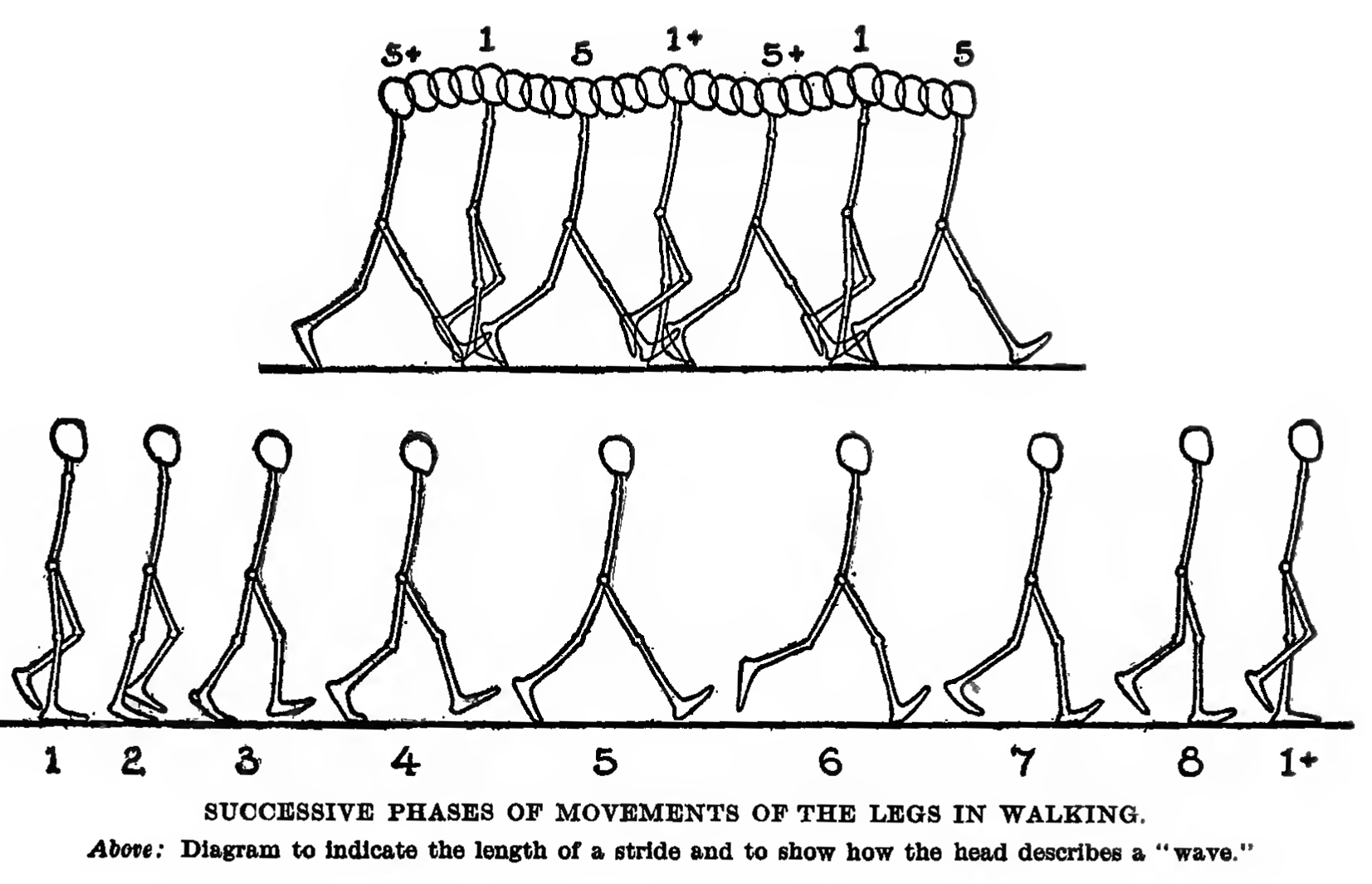
one foot swings frontwards and reaches a sure place, information technology seems to hesitate for an instant and then comes down, heel first, on the footing. As the heel strikes, the body is slightly jarred and the oblique line of the limb, its axis, moves and approaches the vertical. In a moment, the limb is vertical as its supports the trunk and the sole of the foot bears on the ground. Then the centrality of the leg changes its vertical-ness and leans forward, carrying with it the torso. Soon the heel leaves the ground and only the fore part of the foot-the region of the toes-remains on the ground. Simply earlier the foot is entirely lifted from the ground, there is a slight interruption, most immeasurable, coming immediately earlier the foot gives a push button, leaves the ground, and projects the body forward.
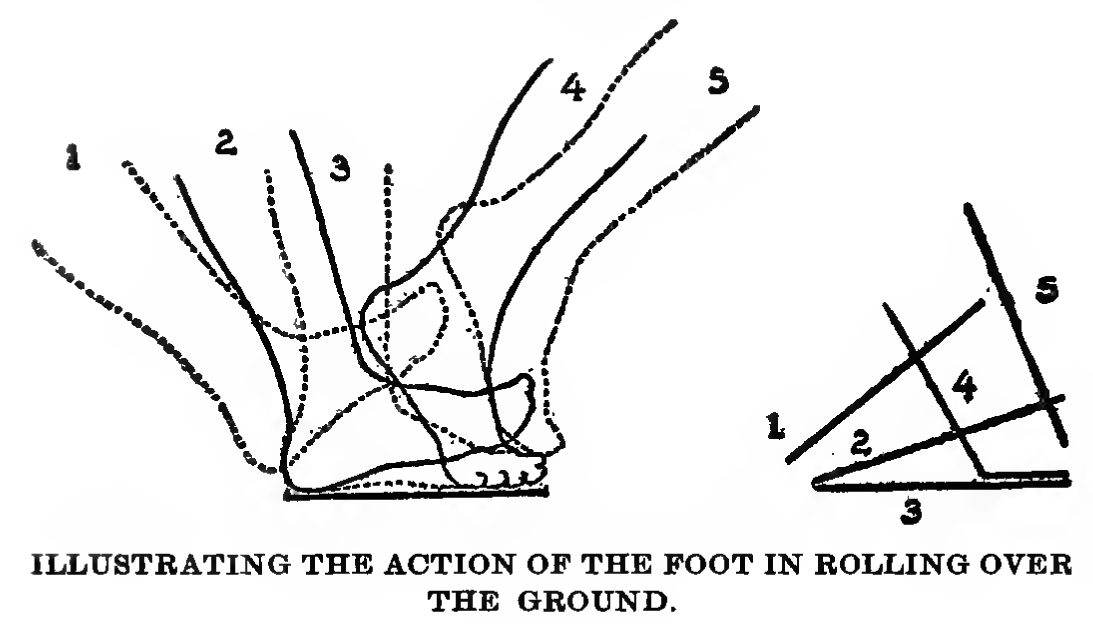
During the fourth dimension of the phases of movement described above, the foot, in a sort of way, rolls over the ground from heel to toes. Immediately afterward the toes leave the ground, the knee bends slightly and the limb swings pendulum-like forrard, then, equally information technology nears the point directly nether the center of the trunk, it bends a piddling more and lifts the foot to clear the ground. After the limb has passed this central signal under the trunk and is first to accelerate, it straightens out prepare to institute its heel on the footing again. When it has done and then it
has completed the stride, and the limb repeats the series of movement phases once more for the next footstep.
Now, the limb of the other side has gone through the same movements, too, but the corresponding phases occurred alternately in signal of time. One of these positions of the leg, that when it is bent at the knee joint so every bit to clear the basis as it passes from the back to its advancing movement forward, is rarely represented by the graphic artist in his pictures. The attribute of the limbs when they are at their extremes-spread out i
forward and one to the dorsum, is his usual. pictorial symbol for walking. But the position, immediately noted to a higher place, is an important phase of move, as it is during its continuance that the other limb is supporting the body.
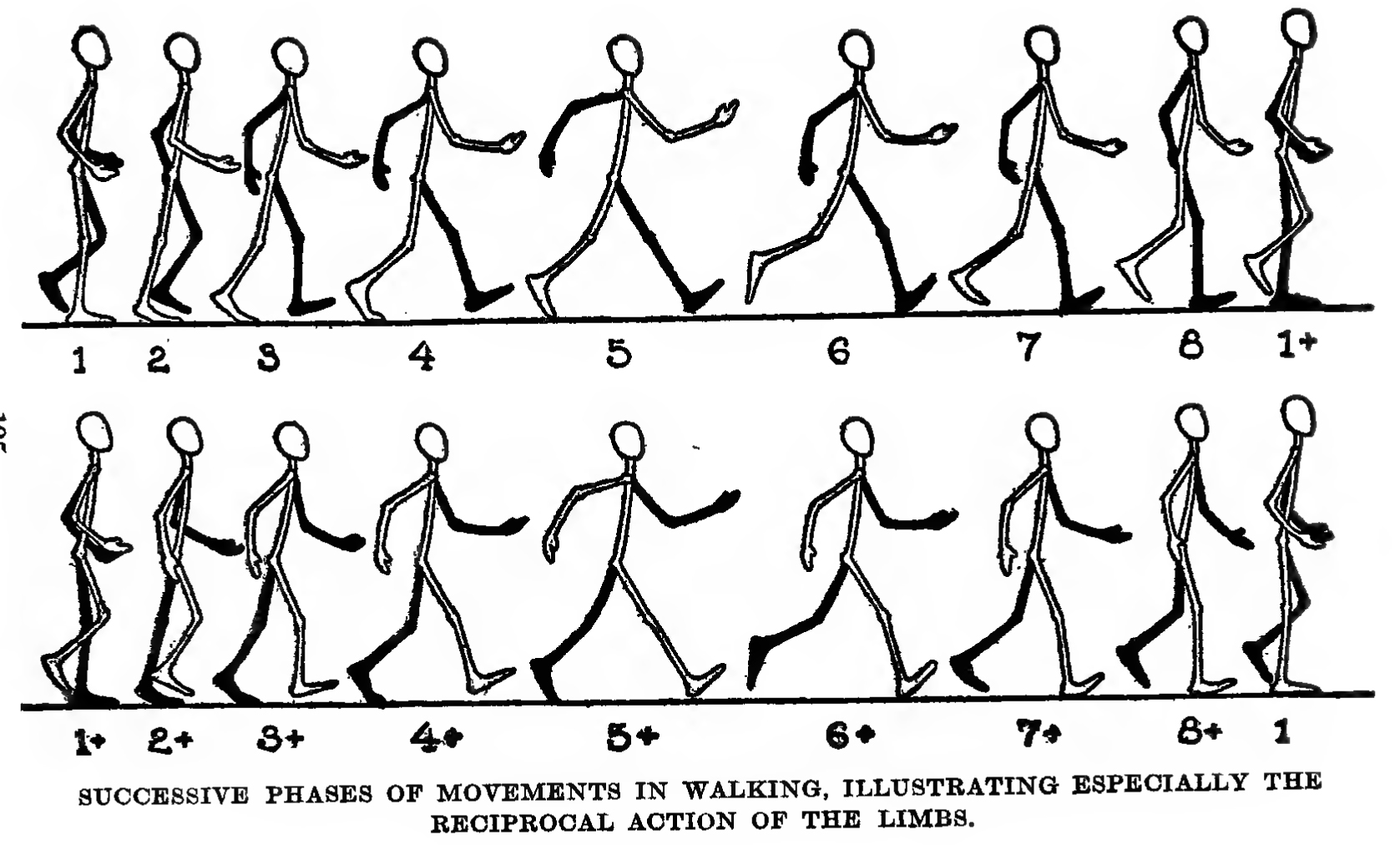
A movement of the body in walking tin be seen turning from side to side equally it swings in rhythm with the upper limbs while they alternately swing forward and backward. Information technology is a movement that animators do not always
call back about, since just an achieved animator tin can imagine motion clearly enough to recreate information technology. To describe the movement better we will consider it visually.
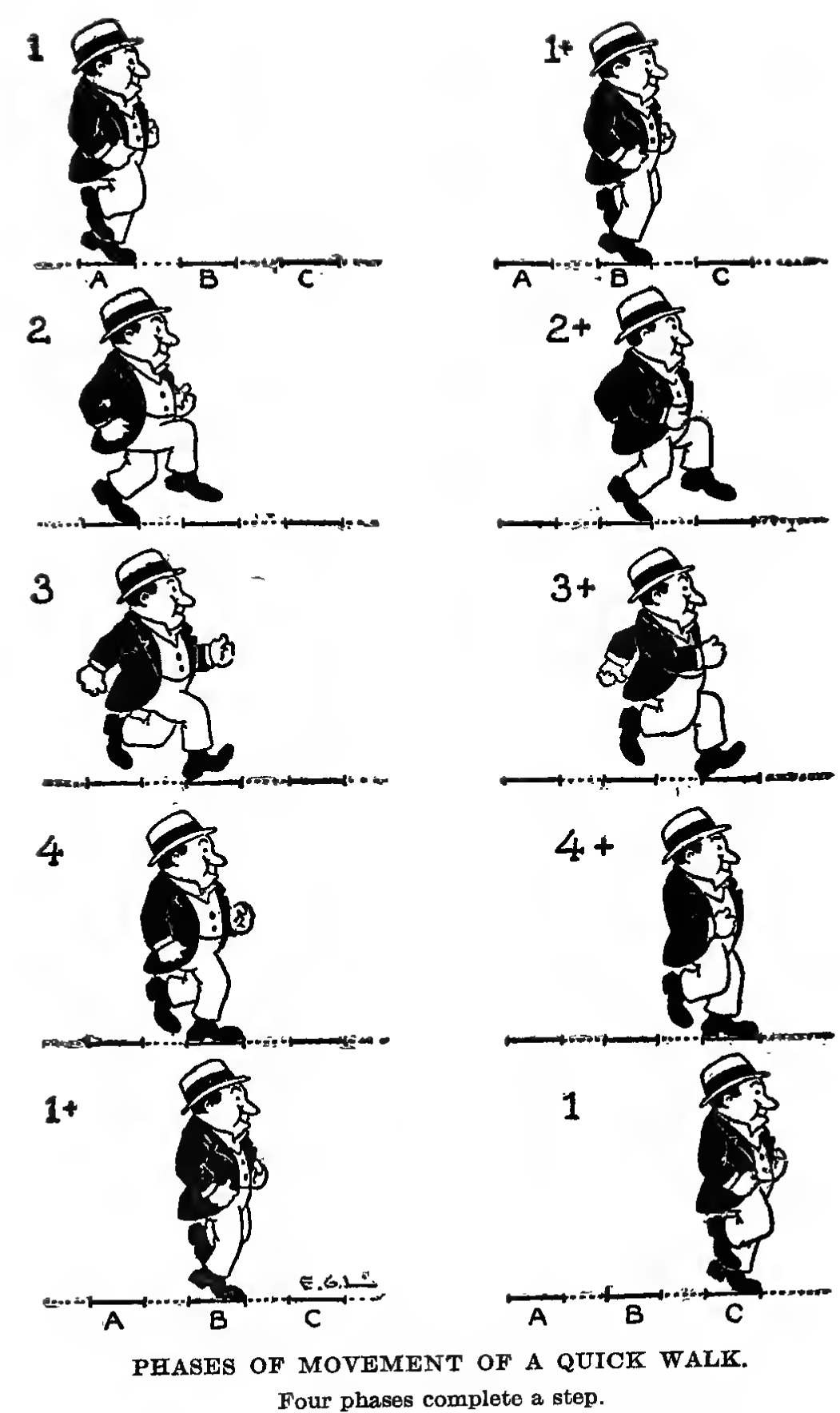
Nosotros are looking at the walker from the side now and tin see the body in profile-exactly in profile. When the walker'south arms are at the middle position. Equally the well-nigh-side arm moves frontwards we see a slight iii-quarter back view of the upper function of the torso / torso, then when the arm swings back we run into the profile once again, and with the arm moving still further dorsum, the corresponding side of the shoulder moves with it and the upper role of
(1) A 3-quarter view from the front;
(2) profile;
(iii) a three-quarter view from the back, and so carries them back and forth
It gives to person, when slightly exaggerated in a funny cartoon picture, a very funny swaggering gait.
The arms were mentioned every bit swinging in a walk and then as to aid maintain the person'southward equilibrium.I don't think you will have a hard time understanding the phases through which they go if you simply remembered that an arm moves in unison with the lower limb of the opposite side. This can exist seen if you go and expect from an upper window down at walkers that are passing by. I want to note that one arm as information technology hinges and oscillates from the shoulder-articulation, follows the lower limb of the opposite side equally information technology hinges and swings from the hip-joint.
Contemplating the arms only, it volition be seen that they go along upwardly a constant alternate swinging back and forth. The point where they pass each other will be when they both have approached their respective sides of the torso. This item moment when the arms are contrary one another and close to the torso, or at to the lowest degree
near the vertical line of the trunk, is coincident with the phases of the lower limb movements when one is nearly rigid as it supports the body and the other is at its median phase of the swinging movement.
These middle positions of the iv limbs-the lower almost to each other, and the upper close to the body-is a feature that you lot should take annotation of and recall. This is a sort of opening movement following by a closing one. These reciprocal changes, expansion and retractions in people and animals, symbolize the activeness
of life.
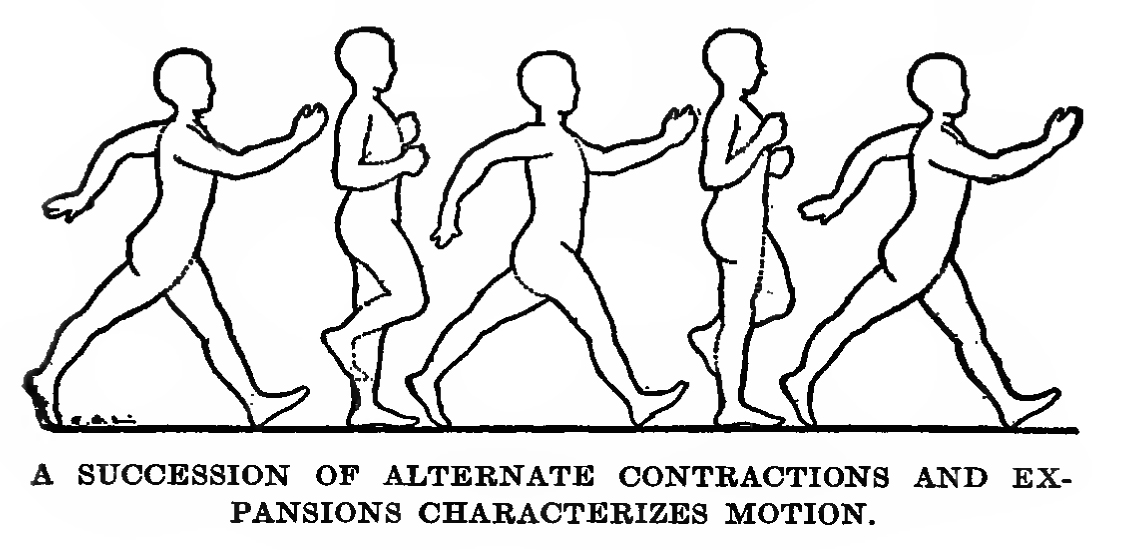
In the human body, for example, during action, at that place are certain times when the limbs are shut to the torso and at other times when they are stretched out or extended. This is can exist evidently seen in the jumping figure. Specifically, this can be seen in the position of the person earlier the actual spring, the appendicular members bend and lie close to the body. The unabridged body is compact and repressed like a jump. And so when the jump takes place, there is a sudden opening every bit the limbs flinging themselves outward.
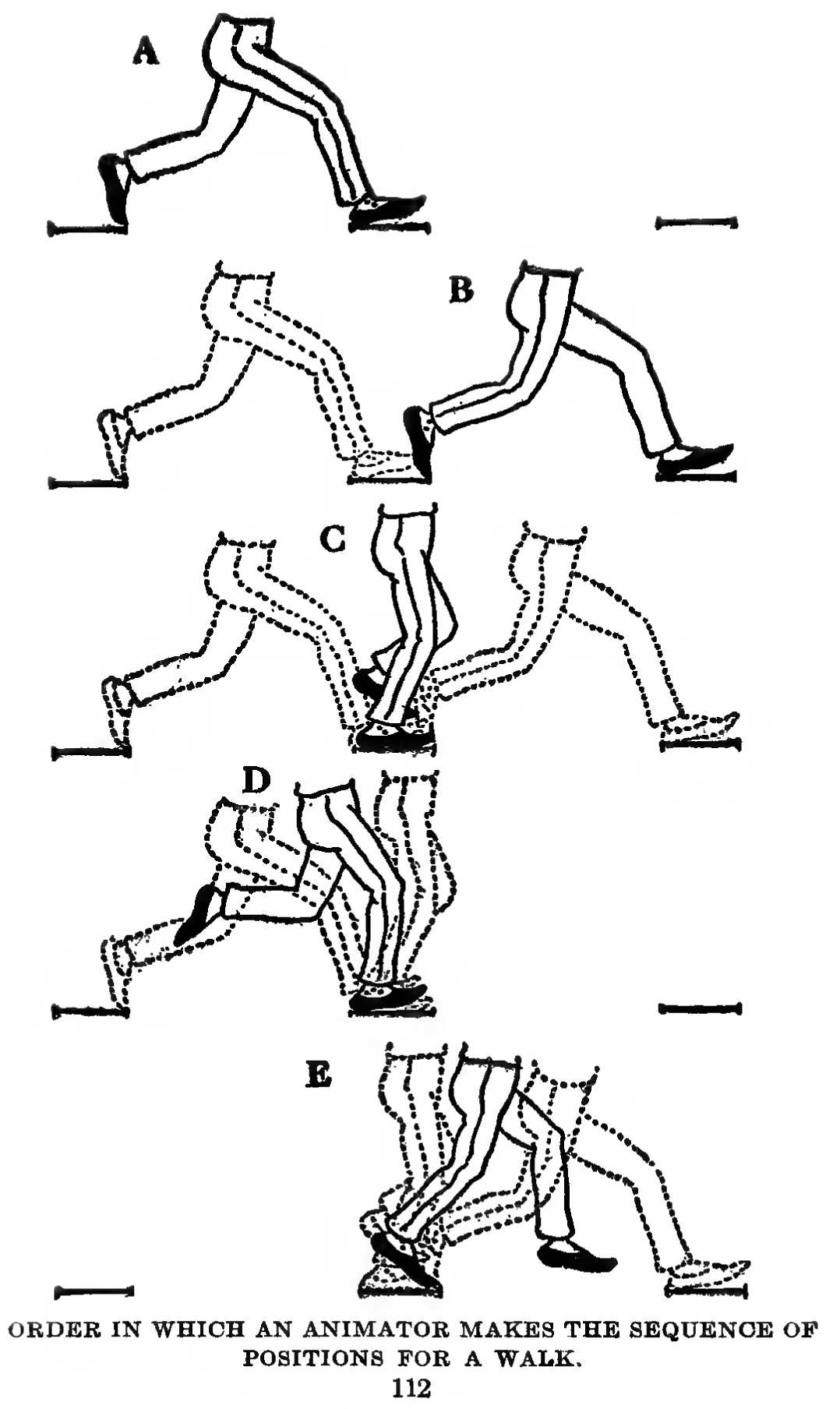
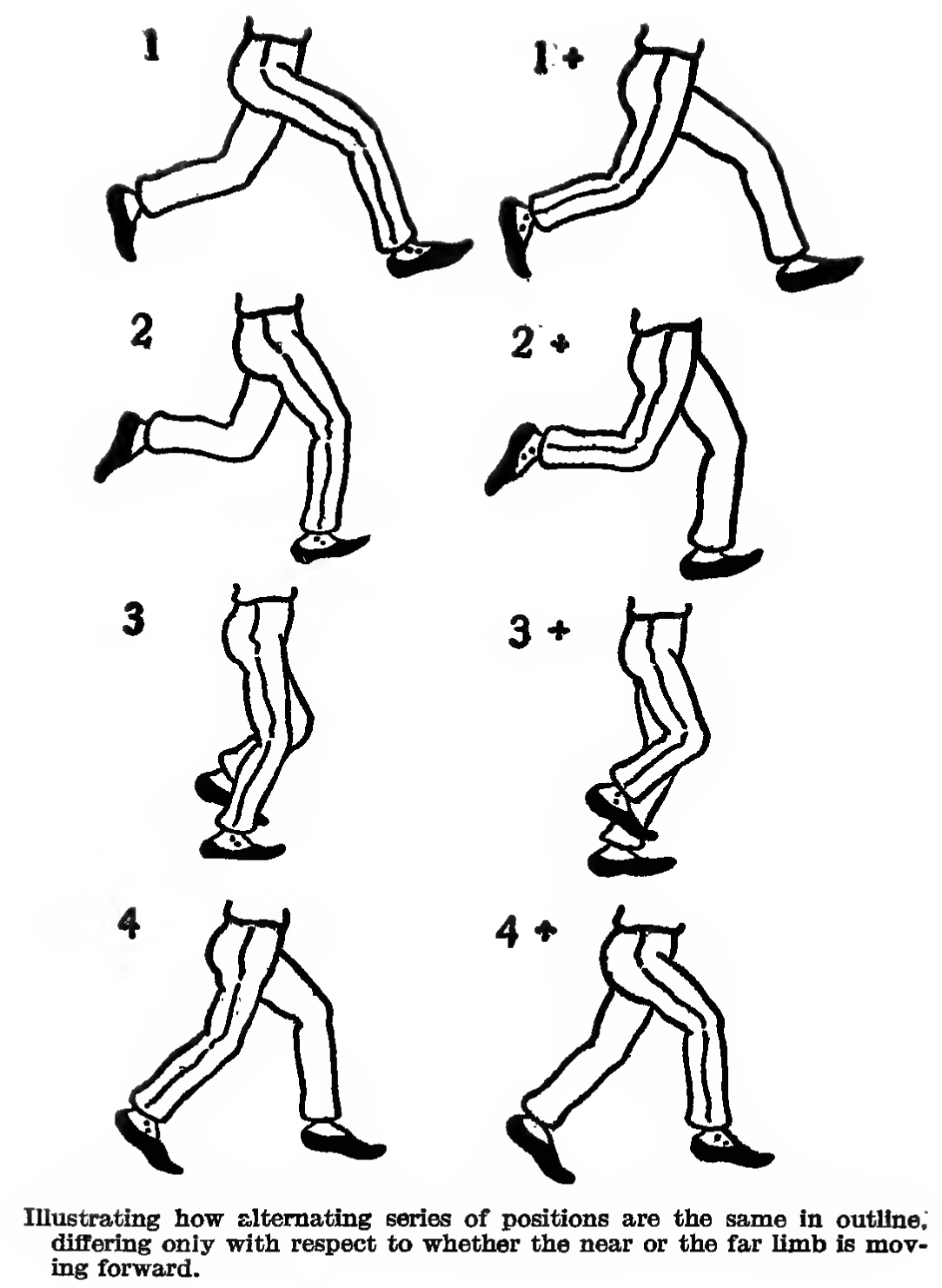
In planning out the positions for a walk, the artist first draws one of the farthermost outstretched positions (A). (Information technology is assumed that we are drawing a figure that is going from left to right.) Then on another sail of newspaper the following outstretched position (B), but placed one stride in accelerate. These drawings are at present placed over the tracing glass of the drawing-board. All the post-obit drawings of this walk are to be traced over this glass, and they will exist kept in annals by the two pegs in the lath. As now placed, the 2 drawings (A and B) cover the distance of two steps. A pes that is most to fall on the ground and one that is nearly to leave information technology meet at a central betoken. Here a mark is made to indicate a footprint. A similar marker for a footprint is made on each side to testify the limits of the 2 steps.
A canvas of paper is next placed over the two drawings (A and B), and on the primal footprint the eye position (C) of the legs is drawn. In this the correct limb is well-nigh straight and supporting the trunk, while the other limb, the left, is aptitude at the articulatio genus and has the foot raised to clear the ground. The next phase volition exist to make the· commencement
in-betwixt position (D) between the commencement extreme and the middle position. Information technology is made on a fresh sail of paper placed over those containing the positions simply mentioned. The attitude of the right limb in this new position would be that in which it is about to plant its foot on the ground and the left limb is depicted as if set up to swing into the position that it has in the middle one (C).
So with the middle position (C) and the final extreme one (B) over the drinking glass, on some other sheet of newspaper, the next in-between ane (Eastward) is drawn. This shows the right foot leaving the footing and the left leg somewhat forward ready to plant its heel on the basis. We have now secured v phases or positions of a walking motion.
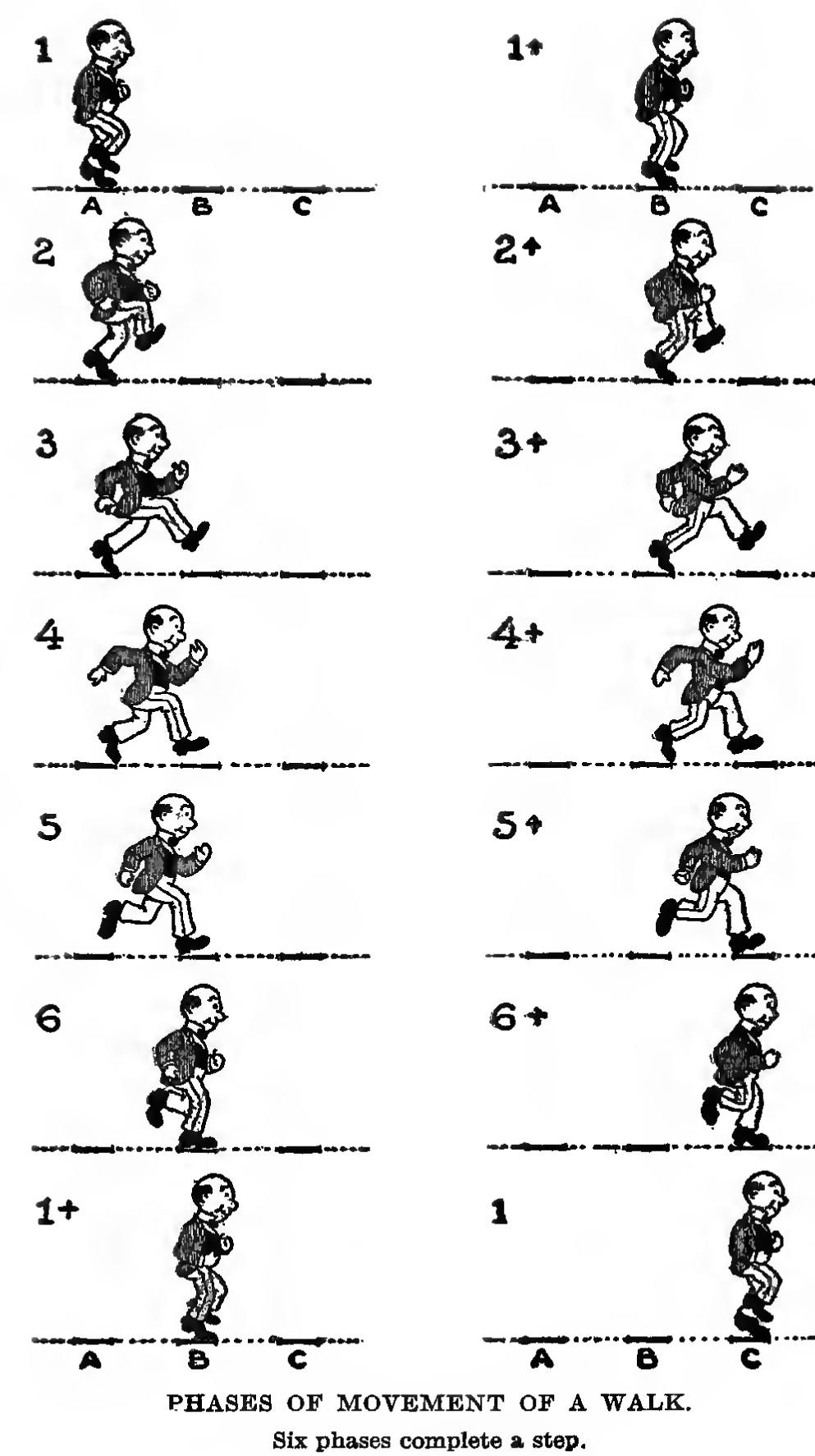
The 2 extremes (A and B) spoken of as the outstretched ones have the same contours simply differ in that in one the right limb is frontwards, and the left is directed obliquely backward, while in the other it is the left limb that projects forrad and the correct has an obliquity astern.
Now, if we make tracings, copying the outlines only, of the three other positions (C, D, and E), but reversing the particular aspects of the right and the left limbs, we shall have obtained enough drawings to consummate two steps of a walk. Every bit a better understanding of the preceding the fact should be grasped that while one limb, the
right we will say, is assuming a certain position during a footstep, in the next step information technology is the plow of the other limb, the left, to presume this detail position. And again in this second footstep, the correct limb takes the corresponding position that the other limb had in the first step. In that location are always, in a walk, two sets of drawings, used alternately. Any particular silhouette in one set has its identical silhouette in the other ready, but the attitudes of the limbs are reversed. To explain by an case: In the cartoon of i heart position, the correct leg supports the body and the left is flexed, in its coincidental drawing, it is the left that supports the body and the right is flexed. (Run across 2 and 3+, of the cartoon 2 in a higher place .. not directly above, simply the one before it).
From this it can exist seen that the two sets of drawings differ but in the details within their general contours. These details will exist such markings as drapery folds, stripes on trousers, indications of the right and the left foot by niggling items like buttons on boots. Heeding and taking the problem to marker little details similar these add to the
value of a screen prototype.
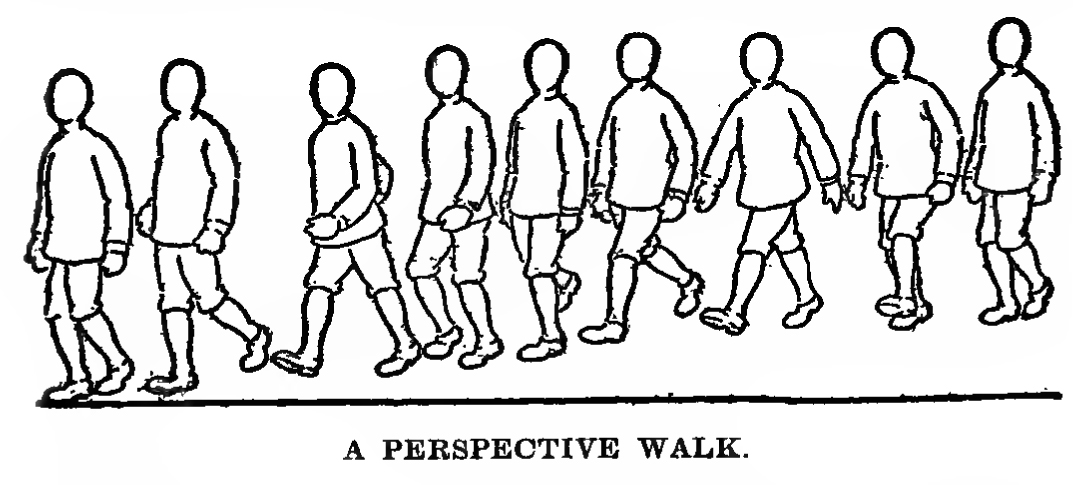
1 of the well-nigh difficult actions to depict in this art is that which the animator calls a perspective walk. By this term he ways a walk in which the effigy is either coming diagonally, more or less, toward the front of the picture or going away from it toward the horizon. It is obvious that according to the rules of perspective,
in coming frontward the figure gets larger and larger, and in travelling in the opposite direction it gets smaller and smaller. To do this successfully is not easy. Only after a worker has had a cracking deal of feel in the art is he able to draw such a movement easily.
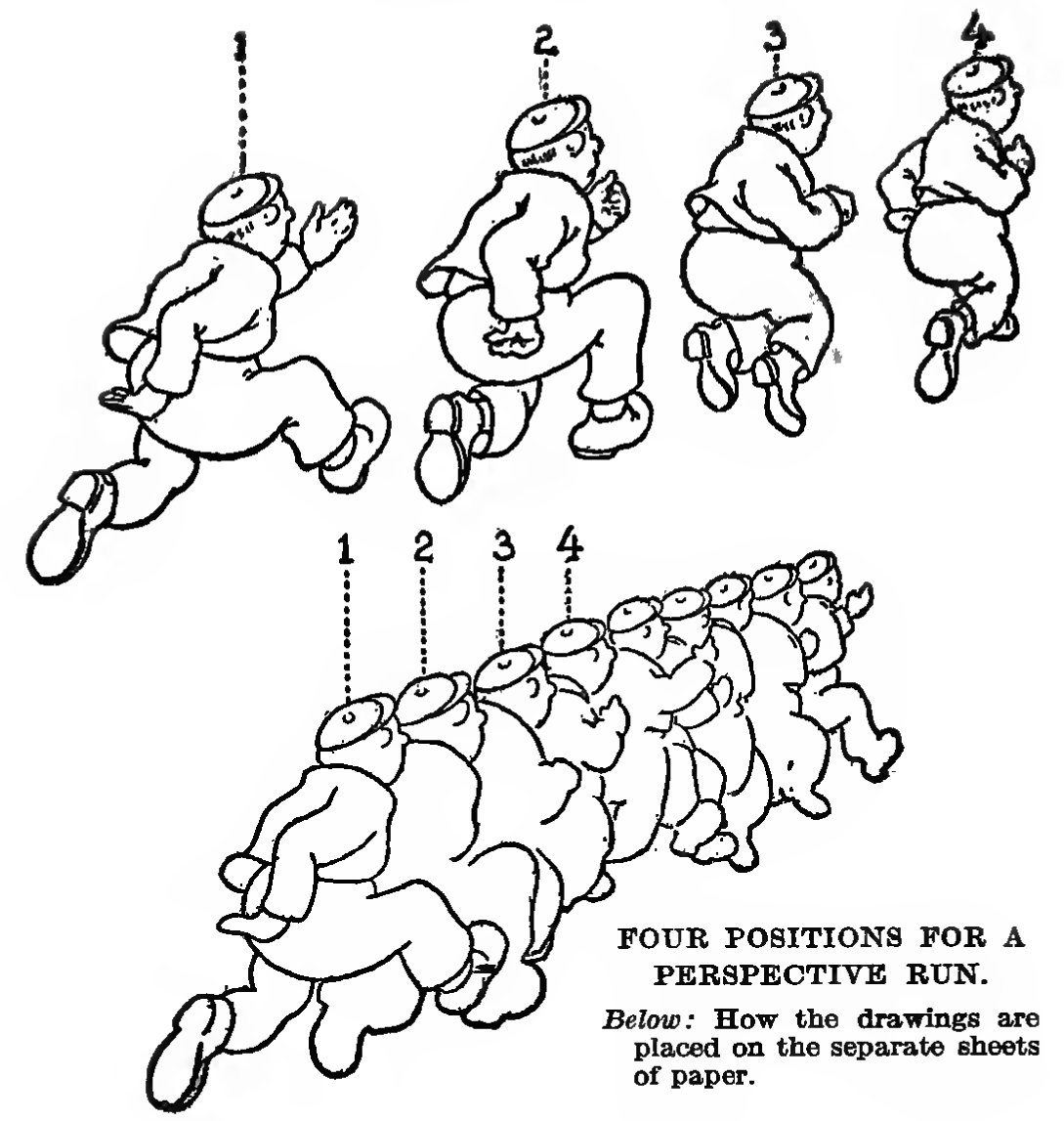
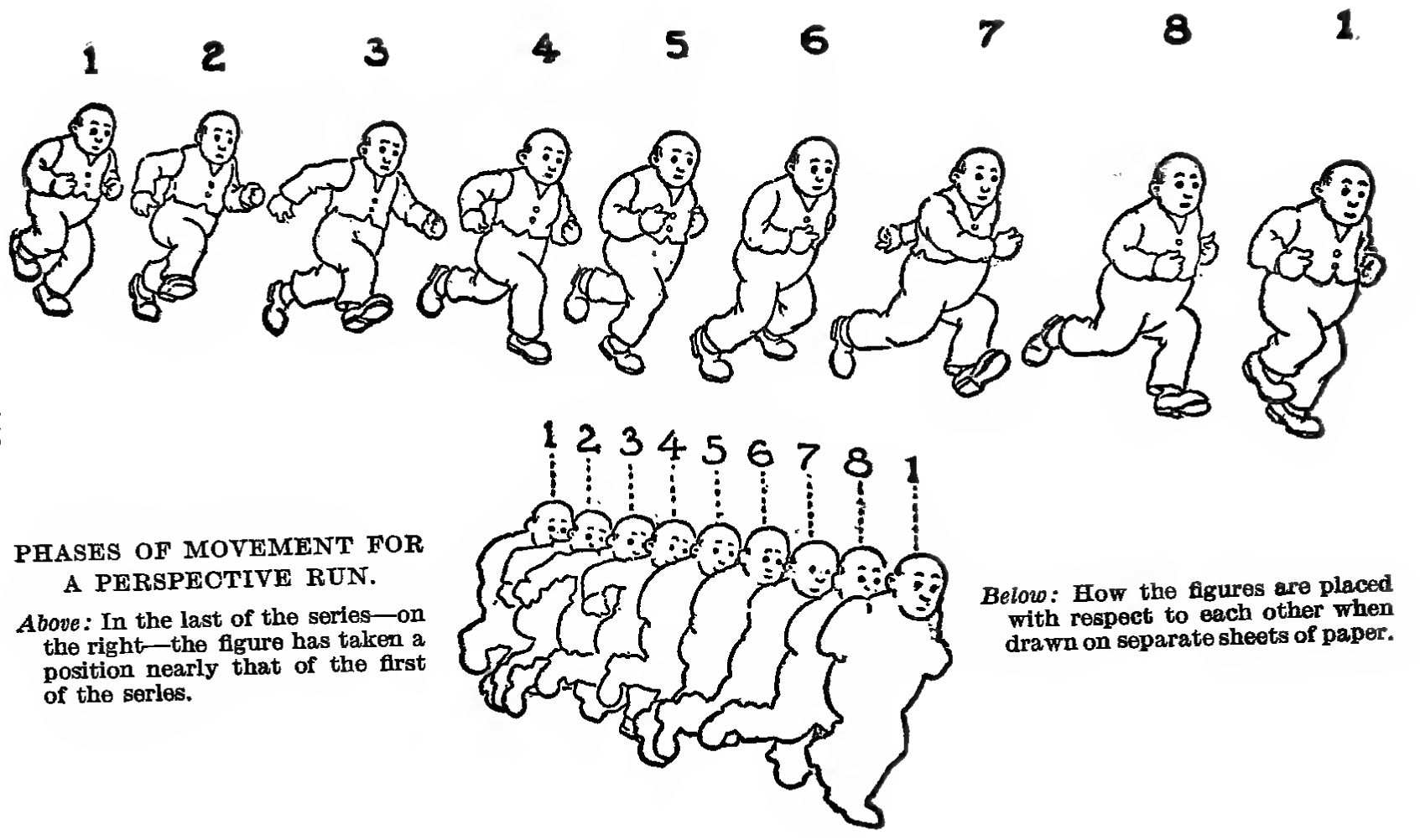
The constant irresolute sizes of the figures and getting them within the perspective lines in a graduated series are perplexing enough matters. But this is not all. In that location is the trouble of the foreshortened views as the limbs are beheld perspectively. Imagine, for example, an arm pointing toward the spectator in a foreshortened view.
Every creative person would have his own individual fashion of cartoon this. Those with a natural feeling for form and agreement anatomy solve problems of this kind by methods for which information technology is incommunicable to give any recipe. Some would beginning with preliminary construction lines that have the appearance of columnar solids in perspective, while others scribble and fumble effectually until they find the outlines that they want.
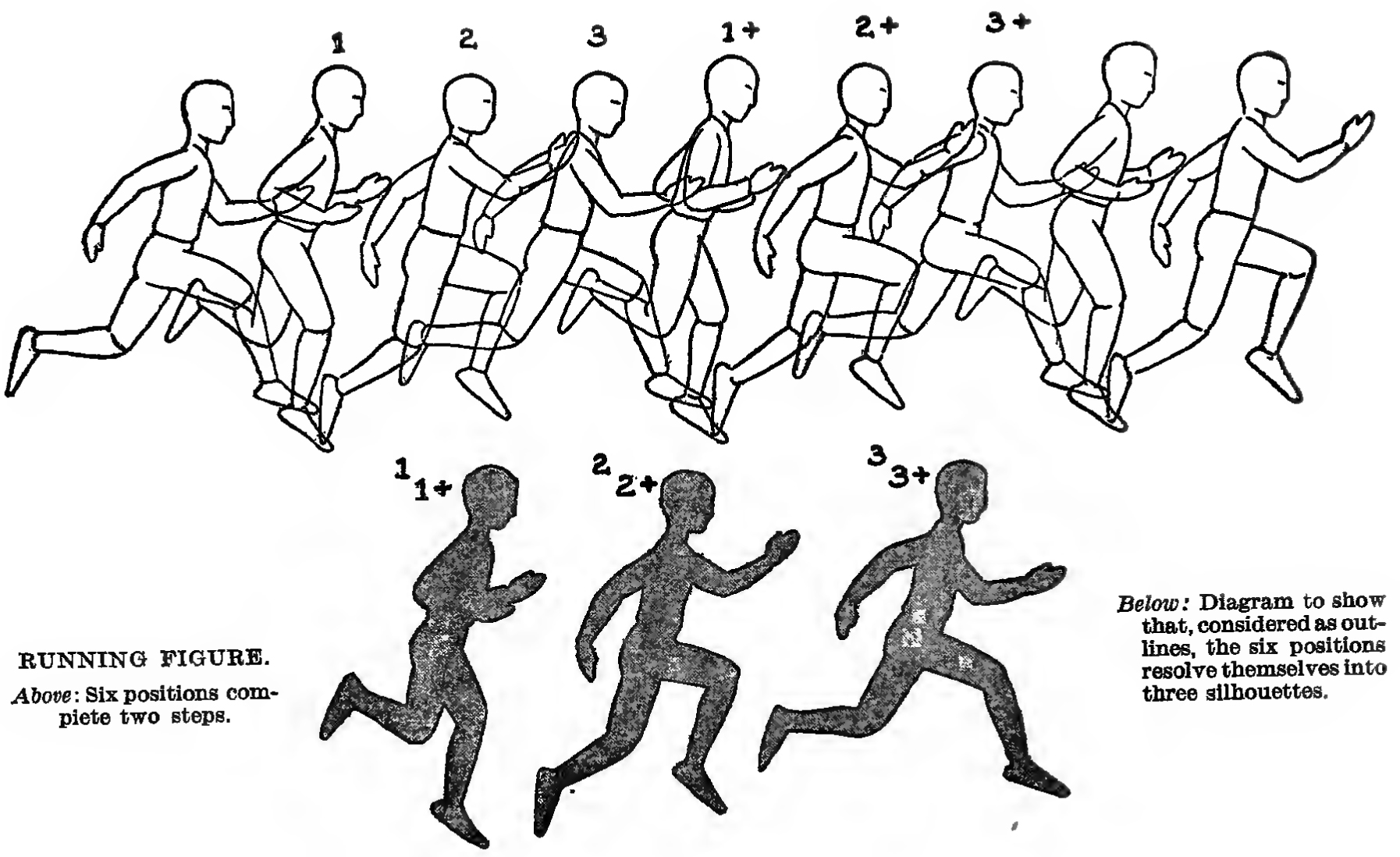
Happily in virtually of the occasions when a perspective walk is required in a story it is for some humorous incident. This signifies that it tin can be made into a speedy activity, and that but a few drawings are needed to complete a stride.
Artists when they brainstorm to make drawings for screen pictures find a new involvement in studying movement. In the report of art the student gives some attending, of class, to this question of movement. Ordinarily, though, the study is not discriminating, nor thorough. But to become skilled in animating involves a thoughtful and analytic
research into the subject. If the creative person is a real student of the field of study its consideration will be more engrossing than the more or less slight study given to the planning of the unmarried isolated phases, or attitudes, of activity in ordinary pictorial work.
A great help in comprehending the nature of movement and grasping the character of the attitudes of active figures are the so-called "analysis of motion" screen pictures. In these the model, by and large a muscular. person going through the motions of some gymnastic or able-bodied action, is shown moving very much slower than the
move is in actuality. This is effected past taking the pictures with a camera so synthetic that it moves its mechanism many times faster than the normal speed.
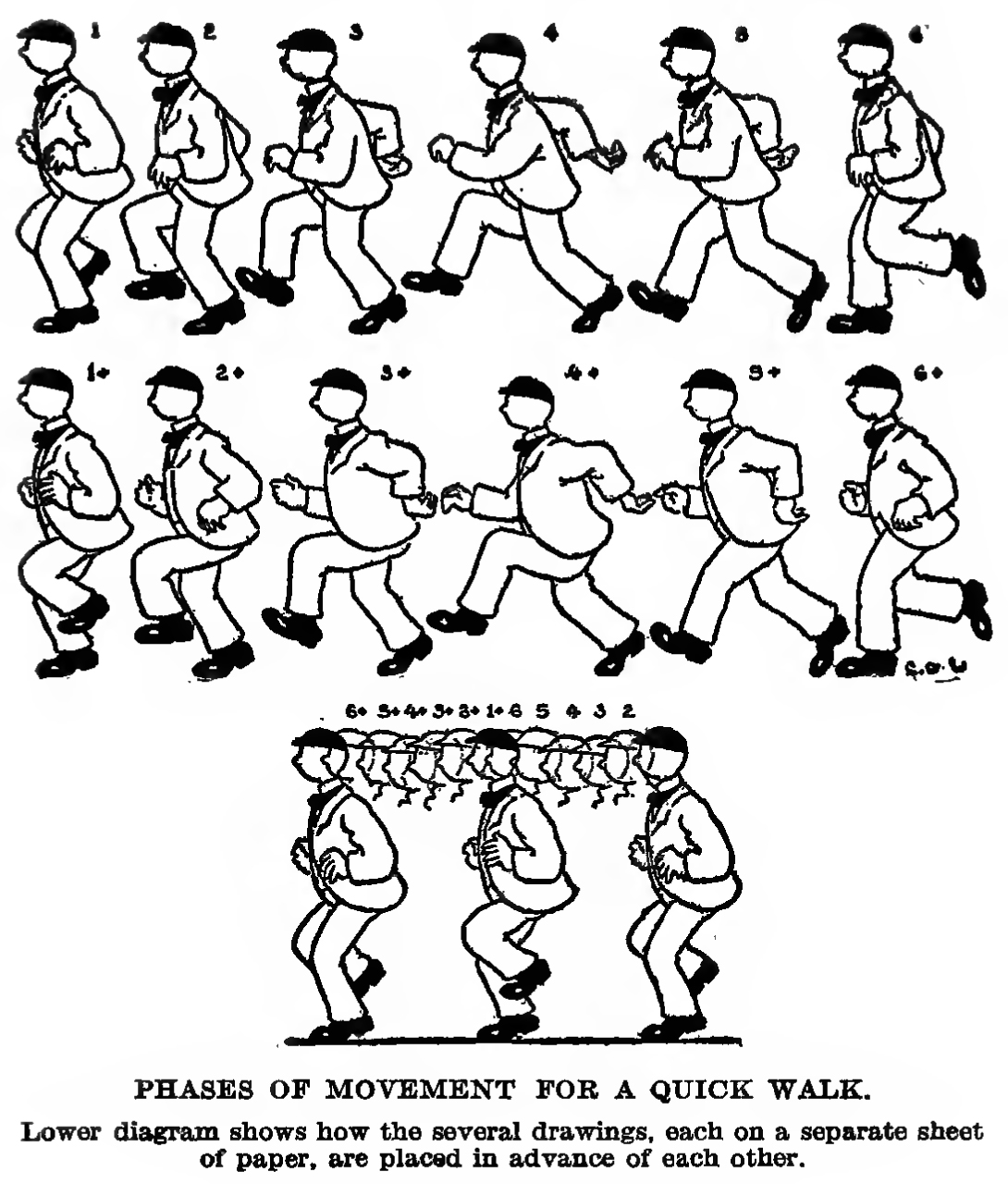
The animated cartoon artist becomes, through the training of his eye to quick observation and the studying of films of the nature immediately noted above, an expert in depicting the varied and connected attitudes of figures in action. Examples for study on account of the clear-cut definitions of the actions, are the acrobats with
their tumbling and the clowns with their antics.
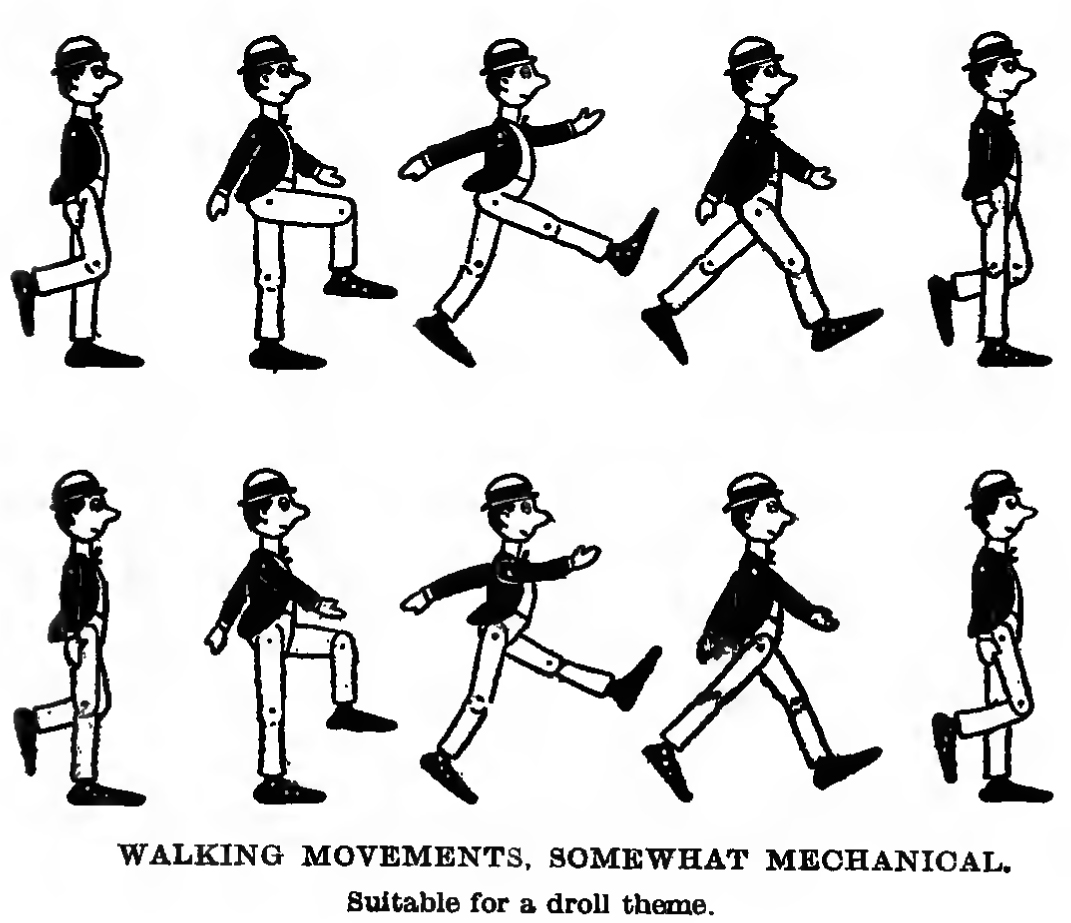
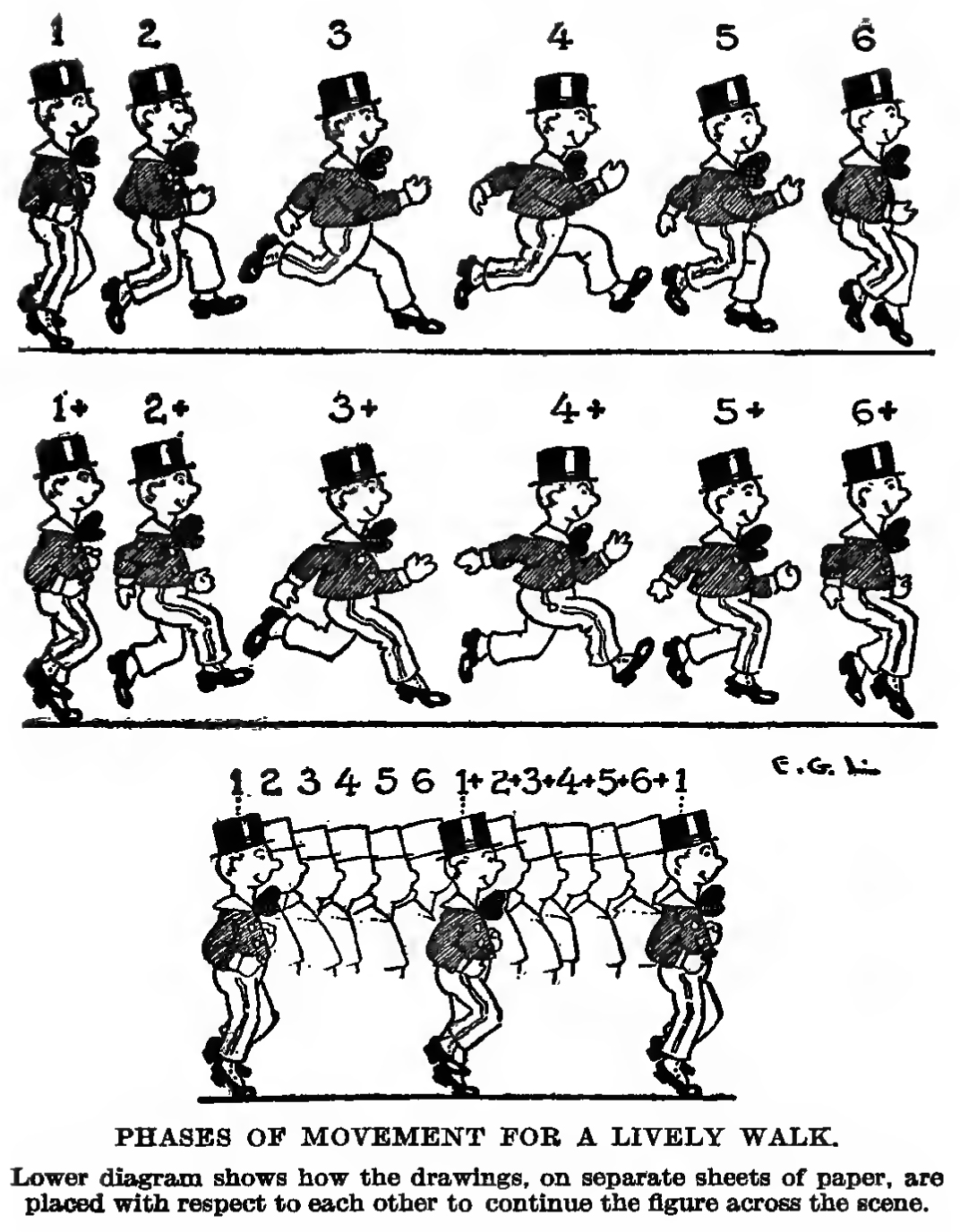
Then in the performances of the jugglers and in the pranks of the knock-near comedians, the animator finds much to spur him on to creative imagery. The pictorial artist for graphic or easel piece of work, in whatever of these cases, intending to make an illustration, is content with some representative position that he tin can grasp visually, or, which is more than probable to be the case, the one that is easiest for him to draw. Just the animator must have
sharp and quickly observing optics and be able to comprehend and think the whole series of phases of a movement.
A fancy dancer, particularly, is a rich study. To follow the dancer with his supple joints bending so easily and assuming unexpected poses of body and limbs, requires attentive eyes and a lively mental· photography. The limbs practice not seem to bend merely at the articulations and there seems to be a most unnatural twisting of arms, lower limbs, and trunk. But it is all natural. It simply means that at that place is co-ordination of motility in all parts of the jointed skeletal frame. This co-ordination-and reciprocal action-follows definite laws of motion, and it is the business organisation of the animator to grasp their signification. It is, in the main, the thing already spoken of higher up;
namely, the alternate action of flexion or a closing, and that of extension or an opening.
With these characteristics in that location is also observable in the generality of dancing posturing a tendency of an upper limb to follow a lower limb of the opposite side as in the cases of walking and running.

Very strongly is this to be noticed in the nimbleness of an eccentric dancer as he cuts bizarre figures and falls into exaggerated poses. For instance, when a lower limb swings in whatsoever particular management, the contrary arm oscillates in the same management and brings its hand close enough to touch this concurrently swinging lower
limb.
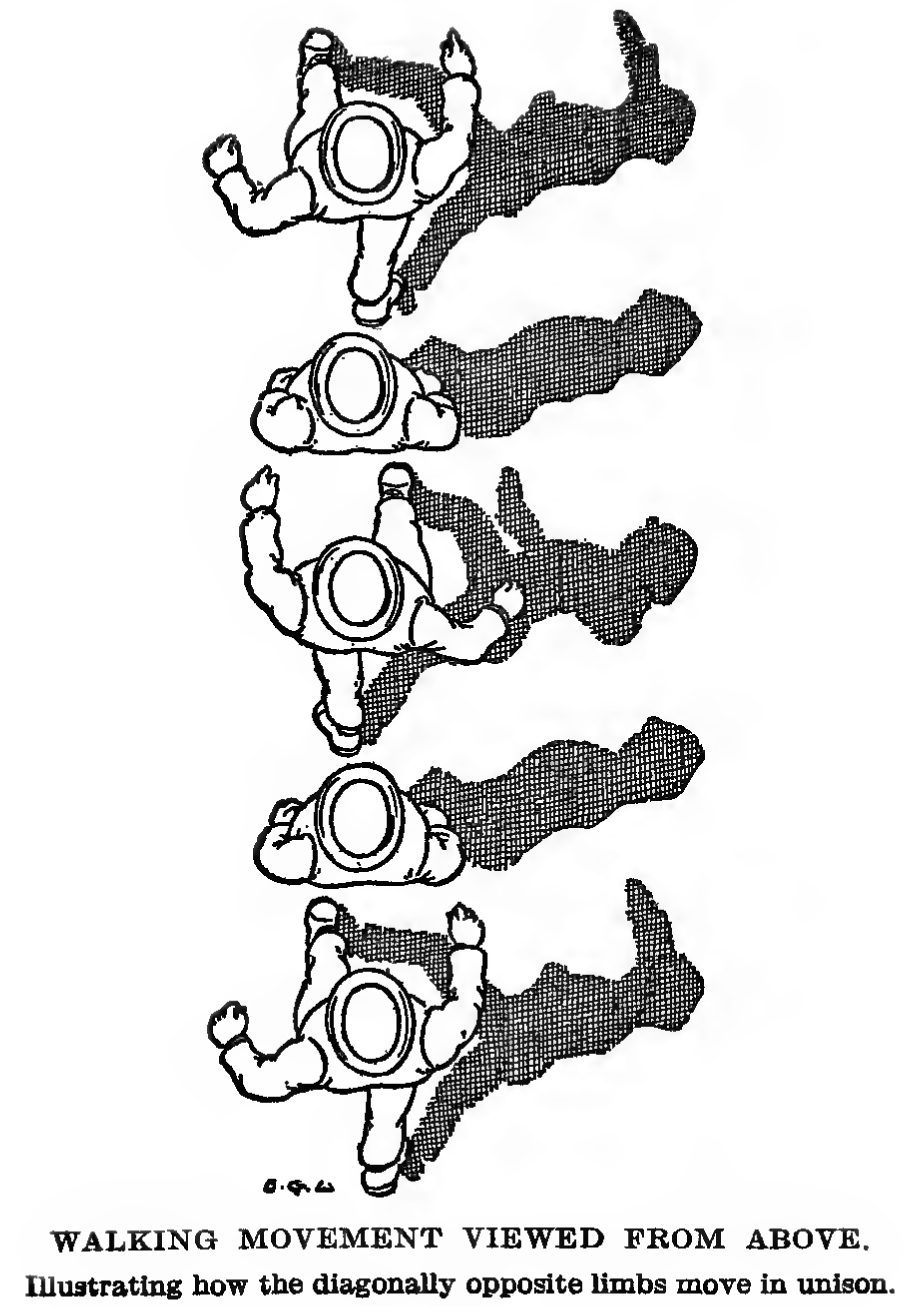
This symbolical phenomenon of the action of living things-the negative quality of a closing or flexion, and the positive one of an opening or extension-is not a feature entirely confined to human beings and animals, but is a characteristic showing in the mechanics of many non-living things.
Technorati Tags: walking, running, how to draw people walking, drawing people walking, how to describe people running, cartoon people running, animate walking effigy, animate walking person, breathing running effigy
Source: https://www.drawinghowtodraw.com/stepbystepdrawinglessons/2016/05/draw-animate-person-walking-running-huge-guide-tutorial/
Posted by: davisbrounally.blogspot.com



0 Response to "How To Draw A Person In A Wheelchair"
Post a Comment